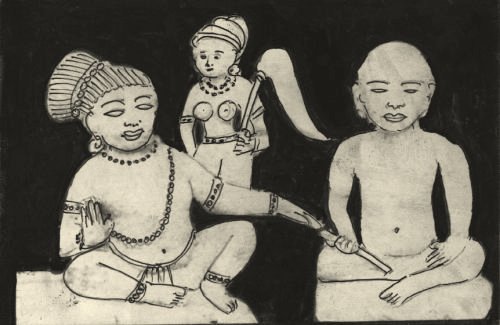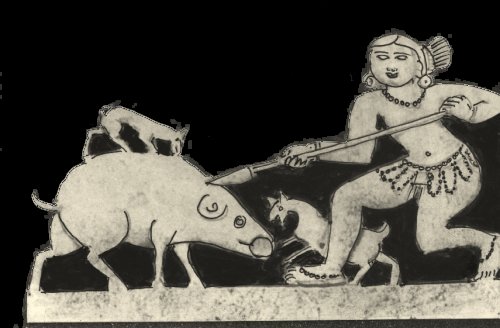Memorials are Illustrated History
Dr. (Mrs.) Jyotsna K. Kamat
Erecting memorials for the dead is an age-old practice in India. Tribals like, Gonds, Korkus, Maria even today execute wooden, stone and other memorials in order to glorify the dead. The dead man is shown as riding a horse or even an elephant though the man never got such an opportunity in his life time! Fortunately, in Karnataka, the memorials were erected in memory of a heroic deed a person had performed and enough care had been taken to depict the person, the event and the surroundings true to life. Hence, these could be profitably used for illustrating the written contents known to the historians. Inscription-part of the memorials has been extensively used by scholars, but the illustrations have remained more or less unexplored. This is an attempt to draw the attention of the historians towards possibilities of using this source for better understanding of a given period of history. Here are two examples:
Chavundaraya
However hard we try to know the life style of Chavundaraya, the tenth century minister and commander who got erected the mammoth, monolithic statue of Bahubali at Sravanabelgola, we really do not hope to succeed. But when one closely scrutinizes Tyagada Brahmadeva pillar on Indragiri Hill of Sravanabelgola, one comes across a beautiful panel depicting a scene from life of Chanvundaraya (Fig. : 1).
© K. L. Kamat

Figure 1: Chavundaraya of Gometeshwara fame.
The panel is followed by a tenth century inscription [1] which gives an account of the battle that Chavundaraya fought against Nolambaraja. The chieftain is shown as middle aged and squatting in front of Nemichandra Siddhanta Chakravarti. Two chowrie-bearers are standing behind the minister, in his service.
Machikabbe
Who will not be touched by the intensity of love and affection that Machikabbe had for her, highly talented daughter, queen Shantala? When Machikabbe came to know of the sudden death of her daughter, she was broken-hearted and undertook a most difficult vow of 'sallekhana' for a whole month under the spiritual guidance of her preceptor, Prabha-chandra and laid down her life by 'Pandita-marana' (a death chosen only by the esoteric learned) in 1131 A.D. [2]. A panel on the top of the inscription (at Sravanabelogola) gives a good glimpse of the last days of Machikabbe. In fulfilling her vow, she has been shown as meditating in front of Jina (Fig. :2). Her limbs are shown as thin and weak as a result of her prolonged fasting and thus her head and hair-bun look very pronounced. She is wearing only a loin cloth and a few simple ornaments. A male and a female chauri-bearers are depicted as worried about Machikabbe's refusal to give up her vow which will eventually lead to her death. We must be grateful to Dasoja for leaving behind a photograph-like sculpture for us.
If we accept that history is an account of not only kings and queens but also their subjects, how they lived, their fashions, accomplishments, achievements and failures, then the memorials have whole lot of information about the common people. The following are only a few examples:
Savinirmadi
A tenth century memorial stone of Kolar district (lying in an open field in Karubele village) tells about a highly accomplished lady, Savinirmadi (Figure 3), daughter of Nagarajunayya and Nandigabbe. It is explicitly claimed that she mastered different branches of knowledge (sarvashastra-prasiddhe....) [3]. The young girl is in simple dress, wears a few simple ornaments and is engrossed in reading. She holds a palm-leaf manuscript in her left hand and trying to interpret its contents. A tavanekolu ( a stool meant to keep the books) is shown by her side. It is evident that the people of the neighborhood who were benefited by her profound learning thought that erecting a simple memorial true to her life would be fitting tribute to her. In the age when education was a privilege of the few, Savinirmadi's achievements are extra-ordinary.
Hariyakka
© K. L. Kamat

Figure 4: Depiction of Hiriyakka in her Memorial
A Shikarpur hero-stone [4] (1446 A.D.) depicts Hariyakka. a brave lady who died fighting the killer of her father, Madigavunda. The illustration (Fig. :4) that goes with the inscription is well planned and executed. Youthful Hariyakka is shown as a tall and strong-willed lady which symbolizes her determination and courage rather than physical strength. The sculpture also gives a good picture of dress and ornaments of the period. Her hair has been done into a concentric knot. The ear-rings appear to be made of palm-leaf (ole-gari). Her other ornaments, are also simple, indicating her humble birth. Her saree, though without a pallu (seragu), is folded neatly into artistic pleats. She is in an attacking stance. A sharp dagger in her right hand has inflicted a deep wound on right shoulder of the killer, while she has held his head in her left hand. The victim has been immobilized by the ferocity of her attack, so much so that he fails to use his dagger for a while. Ultimately the lady dies in the fight as recorded in the inscription.
Saviyabbe
A damaged inscription [5] of Sravanabelagola of the tenth-century fails to give details as to how the end came to Saviyabbe; the details are effected. But the illustration (Fig. :5) that accompanies the inscription compensates this lapse. The gallant lady riding her horse engages her powerful enemy riding an elephant. Sheer physical strength of the enemy she could command and in the process got killed. But for this illustration, we would have been totally ignorant of this heroic lady.
Vama-Sakti II
For unknown reasons Padmarasa, a military officer (Dandanayaka) of Banavasi kingdom, ordered the arrest of the famous Kalamukha precepter. Vama-Sakti II, who headed the Kodiyamatha of Ballegavi for forty six long years. Babey Nayaka, a border guard (meregara) of Tonavati, heroically resisted this treacherous act and died fighting [6]. A hero-stone installed in memory of this event shows the act of imprisoning Vama-Sakti II (Fig. :6). He could be identified by his long tangled hair (jata) and kaupina (kachche). This dress from that shown for all other fighters.
Jirale Mallamma
On the way to Kaduti (Tumkur district) from Siddapur, there is a clean water tank (Kalyani) and people around, whose thirst it quenches, pour two handful of water on a female figure carved on nearby pillar. Enquiries reveal that it is the image of a philanthropist, Jirale Mallamma who did so much for the place and requested in return that the gentry may offer some water to quench her thirst. A copper plate of Gundlahalli of Tumkur district speaks all about her social and constructive works. Here is a living legend of Jirale Mallamma who did so much for society and in return asked so little.
A Hero of Nelavagilu
© K. L. Kamat

Figure 7: Hero of Nelavagilu
A huge hero-stone of Nelavagilu (Hoskote taluk of Bangalore district) depicts a severe fight between the hero and a boar (Fig. :7). A descendant of this man's family narrated the incident which has been remembered from one generation to the other by word of mouth. The hero was all set to celebrate the great festival of Yugadi and was about to partake of the feast when the news came that a wild boar which was playing havoc to crops for quite sometime was sighted in a field. Without a second thought, the hero left with two of his hunting dogs to kill the boar. But he never returned to enjoy the feast. In the fight that ensued the hero got killed along with the boar. In his memory, to this day, his successors do not celebrate Yugadi. But for this tradition, the hero-stone could not have been understood.
Another Example
In the same village, there is another family which commences all auspicious and important functions only after paying respect, offering flowers and fruits to a family hero-stone standing in the adjacent village. Some of the relatives who have left the village also join them in paying respect to an ancestral member of the family. How proud these simple village-folk are when they come to know about the heroic deeds of their great, great grand-father and to find the portraits of these brave men and women preserved in memorials.
Kannadigas of olden times treated their domestic pets with care, love and dignity. Several memorials for their brave dogs speak about the affection their guardians had for them. Here are a few examples:
Loga and Thalaga
An inscription [7] from Mulbagal Taluka of 950 A.D. gives a brief account of two brave dogs, Loga and Thalaga. They accompanied their master, son of Parasandi, in numerous hunting expeditions in which 75 boars were killed by Loga and 26 by Thalaga. One is naturally curious to know the breed of such outstanding dogs. Fortunately the hero-stone of Kattigenhalli gives good illustration of the dogs. The upper half of hero-stone illustrates Loga (Fig. 8) and the lower Thalaga. They belonged to the species of hunting dogs which might have been brought from Banavasi, Mudhol and Andhra Pradesh. It is very evident that they were well fed, cared and trained for hunting.
K.L.Kamat

Memorial for Loga, the Brave Dog
Memorial for Loga, Town of Hoskote
Kali
An Atkuru inscription [8] of Rashtrakuta Krishna III's period, detailing the heroic deeds of a brave hound, Kali, is well known. The illustration of the hero-stone is as informative as the inscription itself. Its master, Manalar, has seen that his loved Kali is depicted stronger and mightier than the wild boar!
The memorials also provide an illustrated account on different facets of social and religious life of a given period. However, this unique source of information is not put to full use by scholars. Researchers interested in dress, ornaments, hair style, flags, weapons, emblems, pets, wars, musical instruments, domestic scenes, arts, crafts, utensils, pastimes of a period can rely upon this authentic information.
Acknowledgements
Dr. R. Sesha Shatri's help in locating the memorials, reading inscriptions and photographing them is gratefully acknowledged.
References
- Epigraphia Carnatica II, SB 388.
- Epigraphia Carnatica II, SB 176.
- Epigraphia Carnatica X, BW 67.
- Epigraphia Carnatica VII SK 2.
- Epigraphia Carnatica II, SB 172.
- Epigraphia Carnatica VII, SK 139.
- Epigraphia Carnatica X, MI 85.
- Epigraphia Indica II. P-171 ft.
![]()
See Also:
- Ordinary Heroes -- Memorials erected for brave men and women in a new research report.
- Stories the Stones Tell -- We demonstrate how history can be assembled through archeological evidence. The memorials spread throughout India are indeed the illustrated history of India.

